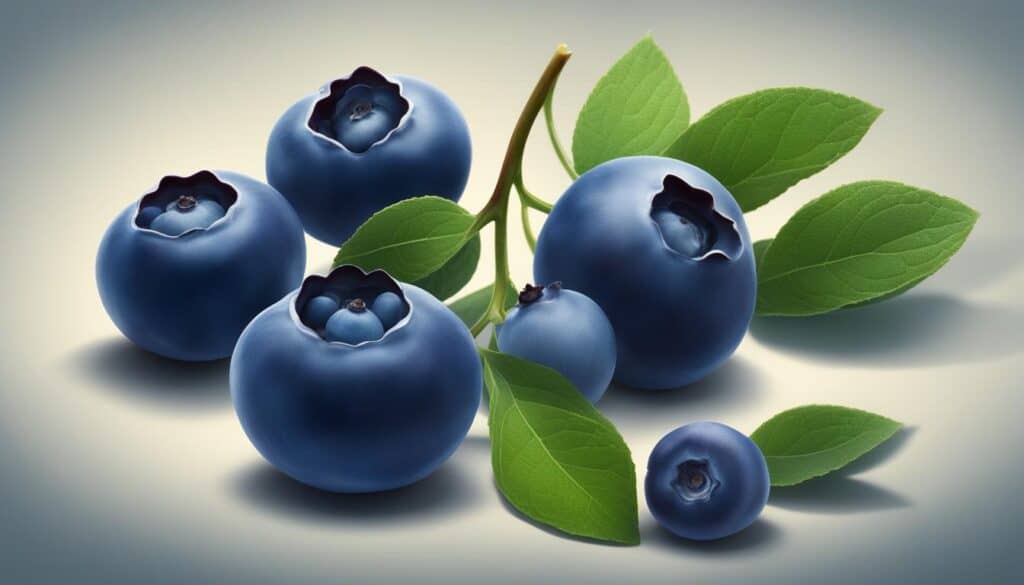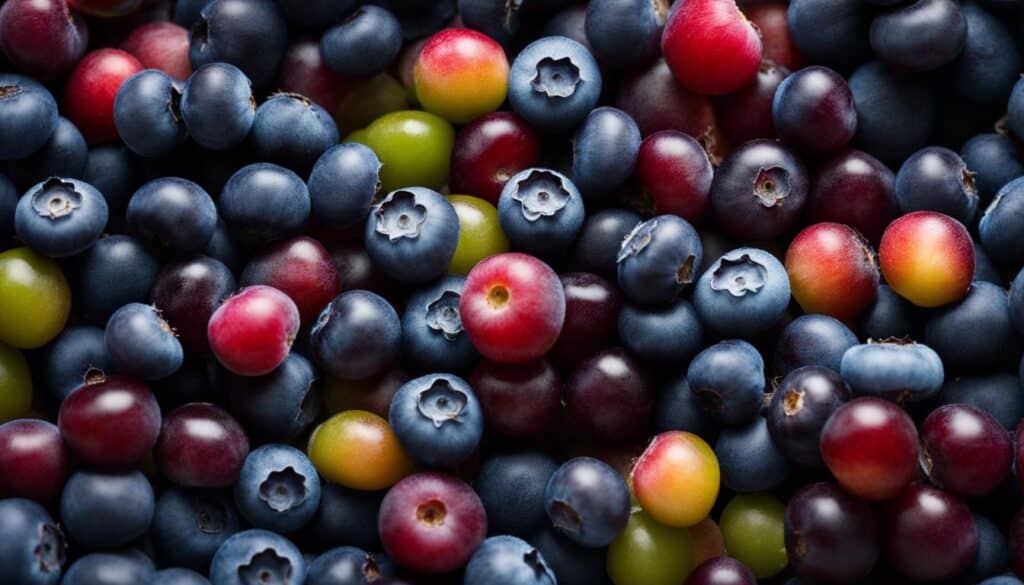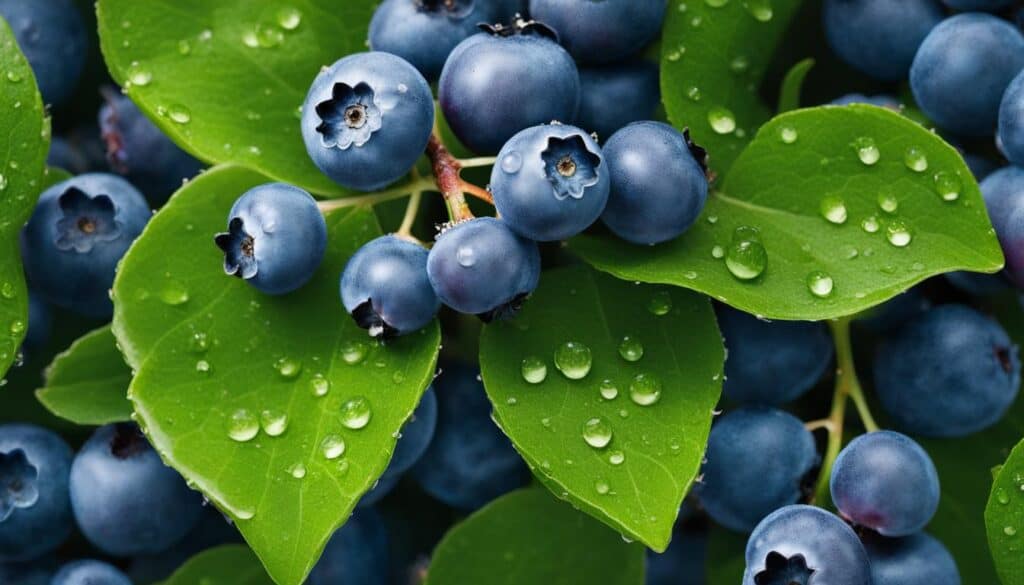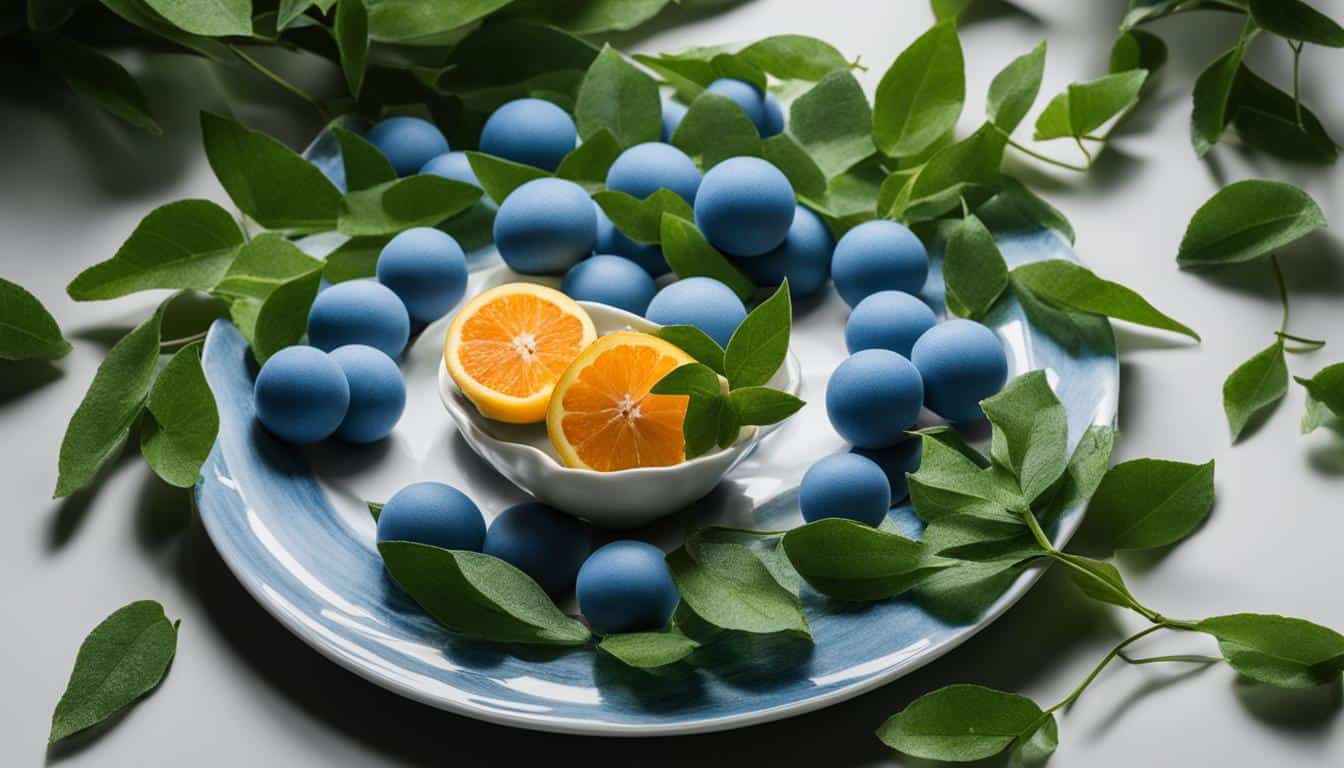Have you ever wondered what fruit are truly blue? We often associate blueberries with the color blue, but are they actually blue? Let’s dive into the colorful world of blue fruits and unravel the truth behind their hues.
Blueberries, despite their name, are not actually blue. In fact, their deep purple color may surprise you. The pigment responsible for their rich hue is called anthocyanin. When ripe, blueberries transform from their initial green shade to a deep purple color. But that’s not all – blueberries can also come in different colors such as green, salmon, and pink, like the unique pink lemonade blueberries. Even the flesh of blueberries varies, ranging from light green to white or light yellow.
Key Takeaways:
- Blueberries are not truly blue, but a deep purple color.
- The pigment anthocyanin gives blueberries their vibrant hue.
- Blueberries can come in different colors, including green, salmon, and pink.
- The flesh of blueberries is light green, white, or light yellow.
- Blueberries start out green before turning purple when ripe.
Are Blueberries Really Blue?
Contrary to their name, blueberries are not actually blue in color. When you take a closer look, you’ll notice that they have a deep purple hue. Native Americans originally referred to them as star fruits, adding to the mystery surrounding their name. Despite this confusion, blueberries are still beloved for their delicious taste and numerous health benefits.
The origins of the name “blueberry” remain uncertain, but it’s important to note that these berries contain high levels of anthocyanin, a purple pigment found in plants. This pigment gives blueberries their vibrant purple color. While the exact reason for the name “blueberry” instead of “purpleberry” remains a mystery, it may have to do with the preference for the sound of “blueberry.”
Next time you enjoy a handful of blueberries, take a moment to appreciate their true color. Although they may not be blue, their rich purple shade adds a touch of beauty to any dish. So, whether you’re adding them to your morning yogurt or baking them into a luscious pie, savor the flavor and the unique color of these delightful berries.
What Colors Can a Blueberry Be?
Blueberries are a versatile fruit that comes in a range of colors. While we commonly associate them with the vibrant hue of deep blue, blueberries can also be green, purple, and even pink. Let’s explore the different colors that blueberries can exhibit and what they signify.
Green Blueberries
When blueberries are still unripe, they often appear green. These green blueberries are not ready to be eaten and can taste bitter. However, they can be pickled, cooked, or used in dressings for a unique flavor experience.
Purple Blueberries
As blueberries ripen, they transition from green to purple. The vibrant purple color indicates that the blueberries are fully ripe and bursting with flavor. These are the blueberries commonly found in grocery stores and used in various recipes.
Pink Blueberries
In recent years, a unique variety of blueberries known as pink lemonade blueberries has gained popularity. These berries have a pink or salmon color, making them visually striking. Pink blueberries have a slightly different taste compared to the traditional blue ones, offering a refreshing twist to classic blueberry flavors.
In summary, blueberries can come in different colors, including green, purple, and pink. While green blueberries are unripe and best used in cooking, purple blueberries are fully ripe and perfect for snacking. The pink lemonade blueberries add a touch of novelty to the blueberry experience. So the next time you enjoy blueberries, savor the variety of colors they come in and appreciate the beauty of nature’s palette.
Why Are Blueberries Purple and Not Blue?
Blueberries are renowned for their rich purple color, but why are they not actually blue? The answer lies in the presence of a pigment called anthocyanin. Anthocyanins are purple pigments commonly found in plants, responsible for giving blueberries their distinctive hue. Despite their name, blueberries contain very little blue pigmentation, if any at all. Instead, it is the abundance of anthocyanin that creates the deep purple color we associate with these delicious berries.
The unique pigment composition in blueberries also contributes to their vibrant color palette. In addition to anthocyanins, blueberries may contain other pigments such as carotenoids, which can give them shades of red, green, or even pink. These natural pigments not only enhance the visual appeal of blueberries but also offer various health benefits.
Blueberries are purple because they contain high levels of anthocyanin, a purple pigment found in plants.
The deep purple color of blueberries may have led to some confusion regarding their name. It is speculated that blueberries were named for their resemblance to berries that were traditionally called “blue.” This naming convention may have been influenced by cultural factors or simply a preference for the term “blueberry” over “purpleberry.” Regardless of the name, blueberries continue to captivate our taste buds and provide a range of nutritive advantages.
So, the next time you enjoy a handful of these delightful fruits, remember that their true colors lie in their purple pigments, showcasing nature’s ability to create a visually stunning and healthful treat. The allure of blueberries goes beyond their name, inviting us to appreciate the wonders of the natural world.
Why Are Blueberries Purple and Not Blue?
| Pigment | Color |
|---|---|
| Anthocyanin | Purple |
| Carotenoids | Red, green, pink |
Are Blueberries Green First?
Have you ever wondered about the journey of a blueberry? It turns out that blueberries actually start off as green before they turn into the vibrant blue or purple hue that we associate with this delicious fruit. Similar to grapes, blueberries begin their ripening process as green fruits. As they mature, they gradually change color and become a deep purple, indicating that they are fully ripe and ready to be picked.
This ripening process is a fascinating transformation that occurs as the blueberries develop and accumulate the pigments responsible for their distinct color. The green color of unripe blueberries is a result of chlorophyll, the same pigment found in leaves that gives them their green hue. As the blueberries ripen, the chlorophyll breaks down, making way for other pigments, such as anthocyanins, which give blueberries their characteristic blue or purple color.
So, the next time you spot a green blueberry, remember that it is simply in its early stages of ripening. Be patient, and soon enough, it will transform into a delectable fruit bursting with flavor and vibrant colors.

Table: Blueberry Ripening Process
| Stage | Color |
|---|---|
| Unripe | Green |
| Ripe | Blue or Purple |
As shown in the table, blueberries undergo a remarkable color transformation during their ripening process. From vibrant green to rich blue or purple, the change in color signifies the perfect time to savor these delightful fruits. So, let nature work its magic and enjoy the journey from green to blue as you indulge in the sweetness of blueberries.
Is it OK to Eat Green Blueberries?
While blueberries are a delicious and nutritious fruit, it’s important to know that green blueberries should not be eaten raw. Green blueberries can be unripe and contain high levels of solanine, a toxic compound that can cause stomach upset and taste bitter. To ensure your safety and optimal enjoyment, it is recommended to avoid consuming green blueberries in their raw state.
However, green blueberries can still be enjoyed in different ways. They can be pickled, cooked, or used to make dressings. Pickling green blueberries can offer a unique tangy flavor and a delightful addition to salads or charcuterie boards. Cooking green blueberries can help break down the solanine, reducing its effects and allowing for a more enjoyable culinary experience. Additionally, incorporating cooked or pickled green blueberries into different recipes can add a touch of acidity and depth of flavor.
When experimenting with green blueberries in the kitchen, it’s important to follow proper cooking techniques to ensure their safety. Be sure to thoroughly wash and remove any stems before pickling or cooking. It’s also recommended to consult trusted recipes and cooking resources to explore safe and delicious ways to enjoy green blueberries as part of your culinary repertoire.
Remember, green blueberries should not be consumed raw, but with the right techniques, they can be transformed into a tasty and unique addition to your meals. So go ahead and get creative in the kitchen with green blueberries, and savor the flavors they have to offer!
What Color Are Bad Blueberries?
When it comes to blueberries, their vibrant colors are often a feast for the eyes. But what happens when those colors start to fade? How can you tell if a blueberry is bad or spoiled? Let’s take a closer look at the signs to watch out for when it comes to determining the color of bad blueberries.
One of the first signs of a bad blueberry is a loss of its blue or deep purple color. As blueberries spoil, their color may become dull or faded, indicating that the fruit is past its prime. Additionally, bad blueberries may appear mushy or have a wrinkled texture. They may also develop mold or soft spots, which are clear indicators that the fruit is no longer fresh and should be discarded.
It’s important to note that while blueberries may vary in color from green to purple, bad blueberries will show obvious signs of spoilage. If you notice any off-putting odor or taste, it’s best to err on the side of caution and avoid consuming the fruit. When in doubt, it’s always better to be safe than sorry when it comes to enjoying fresh and delicious blueberries.
| Signs of Bad Blueberries | What to Look For |
|---|---|
| Faded color | The blue or deep purple color has become dull or faded. |
| Mushy texture | The blueberries feel soft or mushy to the touch. |
| Wrinkled appearance | The skin of the blueberries appears wrinkled or shriveled. |
| Mold or soft spots | The blueberries have visible mold or develop soft spots. |
| Off-putting odor or taste | The blueberries have a strange odor or taste. |
Remember, fresh blueberries should have a vibrant color and a firm texture. If you come across any blueberries that don’t meet these criteria, it’s best to discard them to avoid any potential health risks. Enjoying high-quality blueberries will ensure that you can fully savor their delicious taste and reap their nutritional benefits.
Blueberry Basics: An Introduction to the Fruit
Blueberries are delightful fruits that come in various varieties and offer a burst of flavor. They are known for their nutritional value, making them a popular choice for both snacking and cooking. Let’s explore the different aspects of blueberries, including their varieties, nutrition, and origins.
Varieties
Blueberries come in a wide range of varieties, each with its own unique characteristics. Some popular blueberry varieties include:
- Highbush blueberries: These are the most common and widely cultivated blueberries. They have a sweet and tangy flavor.
- Lowbush blueberries: Also known as wild blueberries, these are smaller in size but pack a powerful burst of flavor.
- Rabbiteye blueberries: These blueberries are known for their high tolerance to heat and are often grown in southern regions.
These are just a few examples of blueberry varieties, and there are many more to discover.
Nutrition
Blueberries are not only delicious but also packed with essential nutrients. They are a rich source of vitamins C and K and contain dietary fiber, antioxidants, and phytochemicals. Blueberries have been associated with various health benefits, including improved heart health, enhanced brain function, and reduced inflammation.
Here’s a breakdown of the nutritional content of one cup (148 grams) of fresh blueberries:
| Nutrient | Amount |
|---|---|
| Calories | 84 |
| Carbohydrates | 21 grams |
| Fiber | 3.6 grams |
| Vitamin C | 24% of the Daily Value (DV) |
| Vitamin K | 36% of the DV |
| Antioxidants | Multiple types |
Origins
Blueberries have a rich history that dates back thousands of years. Native Americans were the first to cultivate and use blueberries for medicinal purposes. They referred to them as “star fruits” due to the five-pointed star shape on the fruit’s blossom end. Commercial production of blueberries began in the early 1900s in the United States, and since then, they have gained popularity worldwide.

| Pigment | Color |
|---|---|
| Anthocyanin | Purple |
| Carotenoid | Red |
| Chlorophyll | Green |
The True Colors of Blueberries
Blueberries may be known for their name, but their actual colors go beyond just blue. These delightful fruits come in a range of vibrant shades, from deep purple and indigo to red and even green. The specific color of a blueberry can vary depending on its ripeness and variety. Let’s explore the diverse color profile of blueberries and the pigments that contribute to their beautiful hues.
Blueberries owe their colorful appearance to the presence of different pigments, primarily anthocyanins and carotenoids. Anthocyanins are responsible for the deep purple and indigo tones, while carotenoids contribute to the red and orange hues in certain varieties. The combination of these pigments creates the stunning palette of colors found in blueberries.
In addition to their visual appeal, the pigments in blueberries also offer health benefits. Anthocyanins, in particular, have antioxidant and anti-inflammatory properties that support overall well-being. This makes blueberries not only a treat for the eyes but also a nutritious addition to your diet.
| Blueberry Color | Pigments |
|---|---|
| Deep Purple | Anthocyanins |
| Indigo | Anthocyanins |
| Red | Anthocyanins, Carotenoids |
| Orange | Carotenoids |
| Green | Chlorophyll |
As you can see, blueberries have a fascinating color profile that goes far beyond just blue. Whether they are deep purple, indigo, red, or even green, these fruits offer a visual feast for the eyes and a delightful burst of flavor. So the next time you enjoy blueberries, savor their true colors and appreciate the wonders of nature.
The Benefits of Blueberry Color
The colors of blueberries are more than just visually appealing; they also offer a wide range of health benefits. The vibrant hues of blueberries are a result of the various pigments present in these fruits, such as anthocyanins and carotenoids. These pigments act as antioxidants, helping to neutralize harmful free radicals in the body and protect against oxidative stress.
Anthocyanins, the primary pigments responsible for the purple and blue colors of blueberries, have been linked to numerous health benefits. Studies have shown that consuming foods rich in anthocyanins can help reduce the risk of chronic diseases, including heart disease, diabetes, and certain types of cancer. Additionally, these pigments have anti-inflammatory properties, which can help alleviate inflammation and promote overall wellness.
“The vibrant hues of blueberries are a result of the various pigments present in these fruits, such as anthocyanins and carotenoids.”
Carotenoids, such as beta-carotene and lutein, are also found in blueberries and contribute to their color profile. These pigments are known for their ability to support eye health and protect against age-related macular degeneration. Furthermore, carotenoids have been associated with improved cognitive function and a reduced risk of neurodegenerative diseases.
By incorporating blueberries into your diet, you can enjoy the flavorful burst of these colorful fruits while reaping the many health benefits they offer. From antioxidant and anti-inflammatory properties to potential protection against chronic diseases, the pigments in blueberries make them a nutritious addition to any meal or snack.

Conclusion
In conclusion, blueberries may not actually be blue, but their deep purple color and range of colors make them a unique and nutritious fruit. Whether they are green, purple, or even pink, blueberries offer a delightful flavor and a variety of health benefits.
The origins of the name “blueberry” remain a mystery, but Native Americans originally referred to them as star fruits. Despite their name, blueberries are not actually blue. They contain high levels of anthocyanin, a purple pigment found in plants, which gives them their vibrant purple hue.
So, the next time you enjoy blueberries, take a moment to appreciate their true colors and the wonders of nature. Whether you’re indulging in a handful of ripe blueberries or experimenting with different colored varieties, blueberries not only add a burst of flavor to your favorite recipes but also offer a range of health benefits.
FAQ
What fruit are blue colored?
Blueberries are commonly known as blue fruits, but they are actually a deep purple color.
Are blueberries really blue?
Despite their name, blueberries are not actually blue, but a deep purple color.
What colors can a blueberry be?
Blueberries can range in color from green to blue to deep purple to salmon and pink.
Why are blueberries purple and not blue?
Blueberries are purple due to the pigment anthocyanin, which gives them their deep purple color.
Are blueberries green first?
Blueberries start out green before turning purple when they ripen.
Is it OK to eat green blueberries?
Green blueberries should not be eaten raw as they can cause stomach upset and taste bitter. However, they can be cooked or pickled.
What color are bad blueberries?
Bad blueberries can have a faded color and should be discarded. The only non-blue/purple blueberries that are safe to eat are pink lemonade blueberries, which are red/pink when ripe.
What are the basics of blueberries?
Blueberries come in various varieties and have nutritional value. They were originally referred to as star fruits by Native Americans, and commercial production began in the early 1900s in the US.
What is the perception of blueberries’ color?
Blueberries may appear blue, but their color is a result of optical illusion and the presence of pigments.
What are the true colors of blueberries?
Blueberries have a complex color profile that includes shades of deep purple, indigo, red, and green.
What are the benefits of blueberry color?
The different pigments in blueberries contribute to their health benefits, including antioxidant and anti-inflammatory properties.
Is there a conclusion about blueberries’ color?
The true colors of blueberries are a fascinating aspect of these fruits, offering a range of shades and health benefits.





Leave a Reply